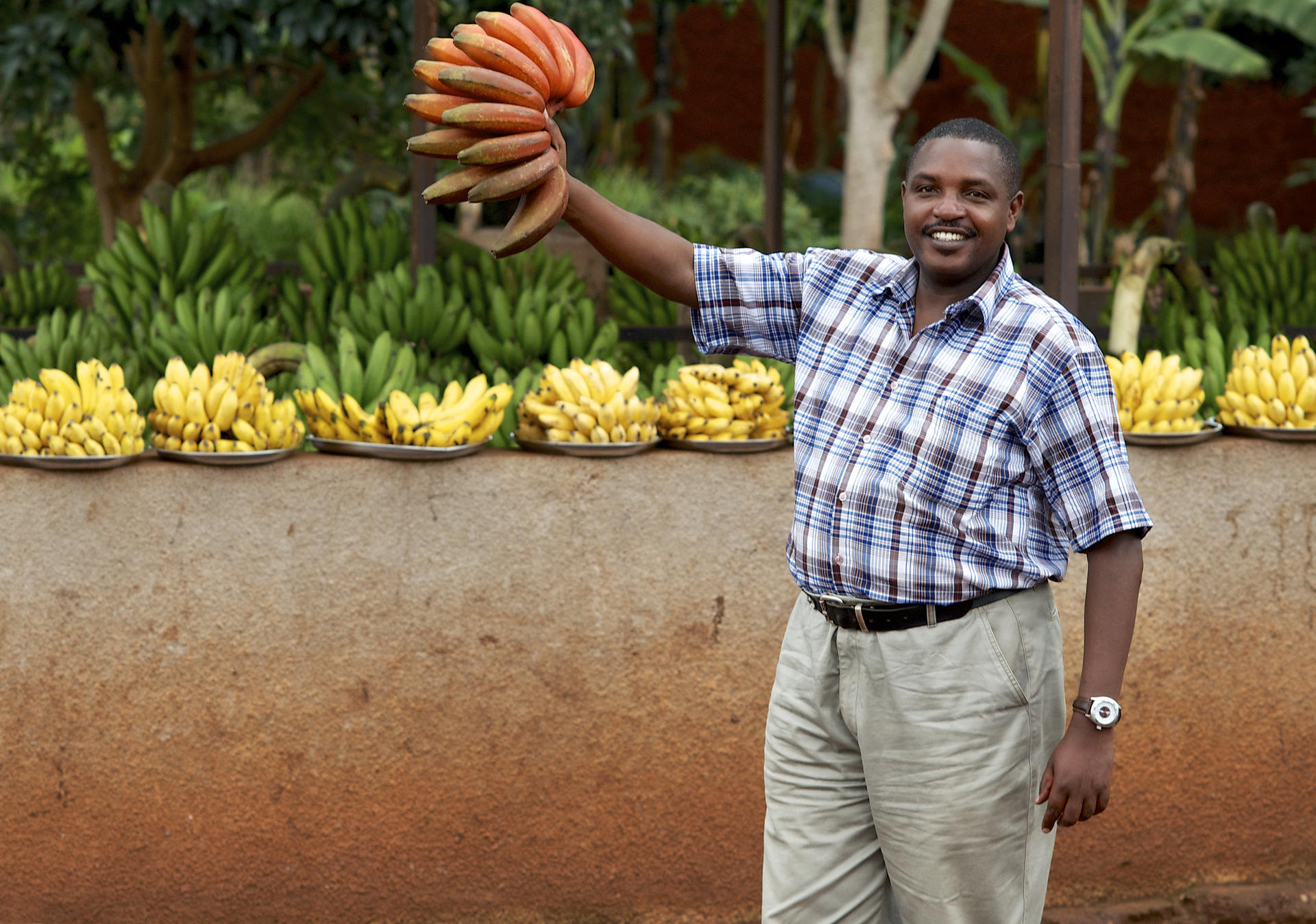Banana research approach

Our research aims to improve banana production and food security for the millions of people relying on bananas for their livelihoods and nutrition.
The Alliance researches the diversity of banana and its wild relatives, building on smallholder farmers knowledge to use this resource, to make production systems more productive and resilient to shocks. Our scientists are working to identify varieties that are resistant to major pests and diseases, tolerant to drought, and suited to the local socio-economic context where they are grown. Alliance’s agroecological intensification approach helps smallholder farmers to better manage pests and diseases, gain access to clean planting material, conserve genetic diversity locally, or take advantage of emerging marketing opportunities.
For over 30 years, the Alliance (ex-Bioversity International) has played a leading role in ensuring the long-term conservation of the global diversity of banana, to provide options for present and future generations. We have specialist scientific expertise in developing protocols and innovative approaches for the medium- and long-term conservation of banana, and through our research contribute to a better understanding of the crop’s selection, adaptation and diversification processes.
Documentation and Information – the Musa Germplasm Information System (MGIS)
The Musa Germplasm Information System (MGIS) is a database of passport data, phenotypic and genetic information on accessions of bananas (both wild and cultivated) conserved in field and in-vitro genebanks worldwide. Please visit MGIS to order material from the ITC genebank.
On MGIS, you can search for or request plant material from the ITC genebank and access data on nearly 7,000 accessions managed in 30 collections around the world, making it the most extensive source of information on banana genetic resources.
Contact information
For inquiries and more information contact:
Featured publication

MGIS: managing banana (Musa spp.) genetic resources information and high-throughput genotyping data
Pest and Diseases and Enhanced Production Systems

Healthy banana crop in a farm.
The Alliance is making progress against important banana pests and diseases across all banana producing regions, from Xanthomonas wilt and banana bunchy top disease in Africa to Fusarium wilt in Asia, Africa and now Latin America. For example, researchers tested the single diseased stem removal (SDSR) approach for Xanthomonas wilt in eastern DRC, and incidence of disease went from 80% to 0.5% within 10 months (Blomme et al., 2019).
Novel surveillance with drone and satellite imagery is used to analyse production zone mapping and health status assessment. AI-powered tools such as the Tumaini smartphone app help farmers identify six banana diseases and one pest.
In addition, efforts are made toward Improving grower income and food security through better production systems. Crop density, frequency of replanting, associated crops and agronomic practices are important areas of research at the Alliance.
Since 2008, intensification strategies – in which yields are increased through harnessing ecological processes – have provided the basis to improve diverse smallholder banana systems. The Alliance also works with partners to strengthen informal seed systems, support conservation of traditional farmers’ varieties and maintain clean banana sucker distribution.
Contact information
For inquiries and more information, contact:
Vitamin-A rich banana diversity in Eastern Africa
Severe vitamin A deficiency is one of the major public health problems in Eastern Africa causing increased susceptibility to infections, and permanent damage to both eyesight and development. The most vulnerable groups are children younger than five and women of reproductive age.
The Alliance looks into missing nutrients in a given population and the nutritional value of the staple foods that feature highly on the menu, to see if alternative varieties could be a better option. There are up to 1,000 varieties of banana around the world, with different naturally occurring levels of nutrients including Vitamin A, and they are a staple food in Eastern Africa, where people eat up to 11 bananas a day. One approach by the Alliance is to look at how better use of banana diversity, using naturally occurring vitamin-rich varieties, within food systems can improve nutrition.
Eating one To'o banana meets the daily recommended intake of vitamin A for women and children. They would need to eat 1kg of Cavendish bananas, the variety that dominates supermarket shelves, to consume the same level.
Varieties identified that are high in Vitamin A pre-cursors perform well under various local growing conditions and are accepted by local communities for taste and use in traditional recipes.
A selection of these varieties is now being officially released in Burundi and Eastern DRC, with more than 500 farmers having received planting material. In addition, a training programme on production, post-harvest handling and nutrition has so far reached over 5000 community members.
Orange-fleshed Fe'i bananas from the Pacific are rich in vitamin A precursors and an important source of good nutrition. The picture compares Karat Pwehu, one type of Fe'i banana, with white fleshed Utin Menihle, peeled and unpeeled.
Contact information
For inquiries and more information, contact:

A banana farmer displays variety of bananas from harvest.

This picture compares Karat Pwehu, one type of Fe'i banana, with white fleshed Utin Menihle, peeled and unpeeled.
